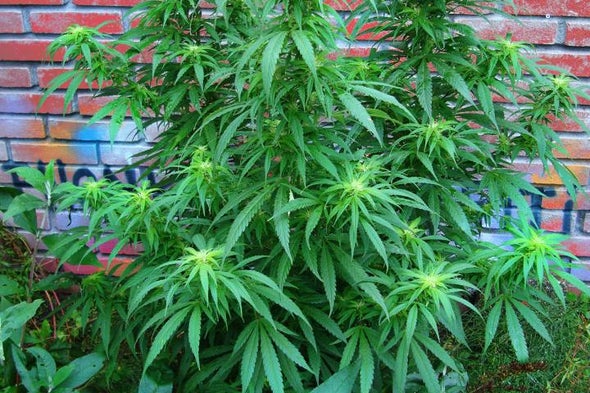(单词翻译:单击)
听力文本
This is Scientific American — 60-Second Science. I'm Christopher Intagliata.
The compounds THC and CBD are known as cannabinoids, because they come from cannabis. AKA marijuana. Now biologists have taken the genes that produce cannabinoids in weed, and plugged them into: yeast.
"Yeah—there's several reasons. The first is cost." Jay Keasling is a synthetic biologist at U.C. Berkeley, who has previously programmed yeast to cheaply produce antimalarial drugs. He says yeast could conceivably produce cannabinoids for about $400 a kilogram—that's compared to the $40,000-a-kilo price tag when using synthetic chemistry.
Other benefits exist, too: "There are about 100 different cannabinoids that naturally occur in cannabis but it's been hard to do research on those because there's not much available. They are produced in such minute quantities in the cannabis you'd have to purify a huge amount of cannabis just to get enough to test."

Keasling says they can even make cannabinoids that don't exist in nature at all, by feeding the yeast certain fatty acids. The resulting cannabinoids, which are chemically similar but not identical to garden-variety THC and CBD, have little appendages the scientists can do chemistry on.
"We could attach an antibody to it and get it to go to a certain location in the human body based on the antibody. We could also put a tail on it so it could be put on a patch and cross the skin, and be used like the nicotine patches. We could also put another drug on it so you'd have a dual action therapy. And this is something that kind of came out of the research that we didn't expect."
The research is in the journal Nature.
Keasling has already founded a new company—Demetrix—to study these yeast-produced medicines. But there are also more mundane things you could do with this technology. Many people are already enthusiasts of the fermented beverages yeast produce. A certain segment of them may also be fans of cannabinoids. With this technology, Keasling says you could produce a THC or CBD beer. Which would give a new meaning to, "This Bud's for You."
Thanks for listening for Scientific American — 60-Second Science. I'm Christopher Intagliata.
参考译文
这里是科学美国人——60秒科学。我是克里斯托弗·因塔利亚塔。
四氢大麻酚和大麻二酚化合物被称为大麻素,因为它们是从大麻中提取的。现在,生物学家已经提取了产生大麻素的基因,并将其塞进酵母中。
“对,这样做的原因有几个。首先是成本。”杰伊·基斯林是加州大学伯克利分校的合成生物学家,他曾为酵母编程,以廉价生产抗疟疾药物。他表示,酵母可以以每公斤400美元左右的价格生产大麻素,而使用合成化学物质生产一公斤大麻素需要4万美元。
另外还存在其他好处:“大麻中天然存在约100种不同大麻素,但人们很难对它们进行研究,因为可提取的大麻素不多。大麻中的这些大麻素非常少,人们必须提纯大量大麻才能获得足够进行测试的量。”
基斯林说,通过给酵母喂食某些脂肪酸,他们甚至能制造出自然界根本不存在的大麻素。由此产生的大麻素的化学成分,与普通四氢大麻酚和大麻二酚相似但并不完全相同,这些大麻素几乎没有科学家可以进行化学研究的附器。
“我们可以在这些大麻素上附上抗体,然后让抗体带其到达人体某个位置。我们还可以追踪大麻素,将其放在贴片上,使其穿过皮肤,像尼古丁贴片那样使用。我们也可以将另一种药物与大麻素结合,达到双重活动疗效。这些是我们此前没有料到的研究结果。”
这项研究发表在《自然》期刊上。
基斯林已经成立了一家名为“Demerix”的新公司来研究这些酵母生产的药物。但你也可以用这项技术做更平常的事情。许多人已经爱上了由酵母酿造的饮料。他们中的一些人可能也是大麻素的粉丝。基斯林说,人们可以用这项技术制造四氢大麻酚或大麻二酚啤酒。这就给“卓越的啤酒为你造”增添了新的含义。
谢谢大家收听科学美国人——60秒科学。我是克里斯托弗·因塔利亚塔。
译文为可可英语翻译,未经授权请勿转载!
重点讲解
重点讲解:
1. be known as 称为;叫做;
The drug is commonly known as Ecstasy.
这种药通常称作摇头丸。
2. come from 来自;始于;
Try to buy wood that you know has come from a sustainable source.
尽量购买来自可持续发展林的木材。
3. compared to 与…相比;和…比起来;
Compared to people living only a few generations ago, we have greater opportunities to have a good time.
比起上几辈人,我们有更多机会享受生活。
4. attach to 缚上;系上;贴上;
We attach labels to things before we file them away.
存档前,我们先贴上标签。


